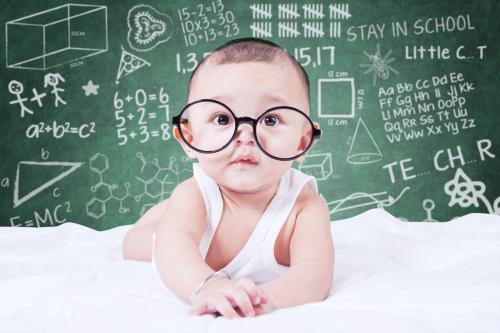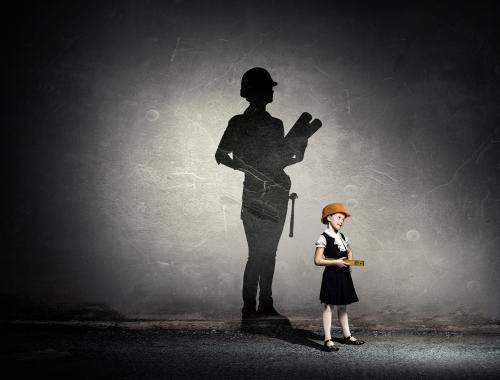Do Children Possess Innate Creativity?
The debate over whether adults or children are more creative remains contentious. Children might not necessarily be more creative, but they might express their creativity more vividly. The claim that children could lose their creativity due to faulty educational practices, as proposed by Ken Robinson in his TED Talk, isn't clearly substantiated. If not nurtured, the ability to think creatively could indeed become dormant, but it is always possible to rekindle it.
The Diminishing of Creativity
Arno Stern, a German war refugee who established the "Malort" (Painting Place) in Paris, observed a decline in creative expression over time. He compares the first two years of a child's life to a book with the first 30 pages missing. According to Stern, free painting could help children "recover" these missing years. Observing children from various countries and cultures, Stern noticed that they didn't paint what they saw around them, but rather what came from within. Whether they grew up in a desert devoid of civilization or in a city, their creations were surprisingly similar. Stern refers to this spontaneous, intention-free expression as "formulation."
However, Stern has noticed that modern children's paintings have become more sophisticated, a trend he attributes to art education in school. Instead of creating from their inner self, children paint what adults - parents or teachers - expect of them. This shift has led children to frequently ask what they should paint when they come to the Painting Place, a question that didn't arise before. That's why Stern views art education - such as museum visits or studying works of art - not as enriching, but rather as restrictive. In Stern's view, adults should respect children and take them seriously, not see them as unformed beings needing education. Only when a child grows in trust and at its own pace can it fully realize its innermost being. This approach was applied by Stern in raising his second son, André Stern.
Children naturally possess ample creative potential. They're curious, spontaneous, love making discoveries, enjoy surprises, and aren't afraid of mistakes or criticism. They also don't care if they excel at anything. Moreover, they don't have ingrained habits, enabling them to act freely. Joanna Żarniewska, a daycare educator specializing in creativity, has found that in an open, friendly atmosphere, all children enjoy creative activities.

Elisabeth McClure, who researches creativity and learning, argues that while children possess vast imagination, it doesn't automatically make them more creative. Children offer original suggestions, formulate new ideas, exhibit flexibility in thinking, explore their environment, and take risks. However, many of these ideas are impractical. As an example, she cites a child's idea of building a pool in a treehouse - a fantastic concept but hardly feasible.
Besides divergent thinking, which children excel at, convergent thinking is also necessary. This involves evaluating the feasibility of an idea.
If a person is overly inclined toward divergent thinking, they generate many ideas but may lack the analytical skills or perseverance to actualize them. On the other hand, if one leans too heavily on convergent thinking, they might fail to recognize great ideas. Thus, a balance is needed.
McClure proposes forming co-creative teams of adults and children, where both parties look to each other as role models and inspire each other. The children develop many high-quality ideas, and the adults gain inspiration from them. In McClure's view, companies should view children not just as future consumers, but as co-creators of products. Similarly, in the classroom, children should be considered not just as knowledge consumers but also as co-teachers. She advocates for more alternative approaches in education. While she doesn't consider children to be creative geniuses, she believes we can learn much from them.
Kids Team UW
Co-teams of adults and children are indeed in operation, for instance, at the University of Washington. Here, children aged seven to eleven work with scientists to develop technologies for other children. The "Kids Team UW" helps programmers think like children. In this new form of usability studies, kids test prototypes rather than nearly finished products. This allows them to influence the development process early on. The child-adult team at the University of Washington works on projects for Microsoft and Seattle's Children's Hospital. Beyond producing useful items, the children thoroughly enjoy their "work."

Is School Detrimental to Creativity?
How does school influence creativity? Here, we're not discussing groundbreaking creativity that results in strokes of genius, but rather everyday creativity that helps solve common problems. Although some teachers strive to ensure schools don't stifle children's creativity, the overall success is limited.
Heinz von Förster, an Austrian-American epistemologist, once described schools as institutions of trivialization that produce predictable, functional individuals. Even today, unconventional answers like "violet" to the question "What is two plus three?" are deemed unacceptable. Why can't it be "violet"? Encouraging the child to explain their reasoning could stimulate creativity.
Creative ideas are unpredictable and can disrupt the classroom. They often seem less significant than hard facts. Divergent thinking tends to be punished and met with poor grades. Also, because creativity exists outside the system, it is difficult to grade. Students often perceive the grading of creative projects as unfair. Yet, they've become accustomed to constant grading and lack motivation without it.
Olaf-Axel Burow, a teacher and professor of general education, refers to schools as factory-like organizations. Students are grouped, progress along an assembly line, and learn the material within a given timeframe. School performance is even being standardized globally, heavily influenced by the PISA study. This push towards standardization, argues Burow, is misguided, given that learning is a highly individual process. The result: children aren't doing well. In South Korea, a nation with a tightly organized school system and high student performance, children are notably unhappy.

In the U.S., too, standard tests mostly assess memorization rather than comprehension or creativity. They require mere knowledge reproduction. Despite the vast amount of knowledge in our world, schools can only impart a fraction of it. Emotions, which aid learning, or even fun, are often sidelined. Children primarily learn about discoveries made by others, while it would be much more beneficial if they could make discoveries themselves. That's when real learning experiences occur, which are far better imprinted on the brain than information coming from a teacher.
Schools should encourage students to ask questions and find the answers independently, not presume to know all the answers. This approach would foster creative thinking. After all, in many subjects and for many questions, there isn't a single correct answer.
Currently, according to Tillmann and Nadine Nett of Fernuniversität Hagen, the creative act consists of discerning what the teacher wants to hear. Teachers confirm or reject answers without students having the opportunity to validate their findings. Throughout their school years, students accumulate knowledge, but often lose their imagination, independence, and initiative. The paradox of our school system, Tillmann and Nadine Nett argue, is that children learn according to predefined patterns, yet they are expected to act independently and creatively at some point.
Quite intriguing, isn't it?
Scoring good grades is often celebrated, yet it doesn't necessarily indicate a genuine interest in the subject or predict future academic or career choices. Yes, some young people may select their field of study or career path based on financial stability. However, it's typically an interest in the subject that determines one's professional trajectory.

What about teachers?
Teachers generally consider creativity important. Yet, like much of the public, they often hold misconceptions about it. In particular, in Germany, it's widely believed that creativity is innate and cannot be learned. Consequently, universities don't offer creative writing courses, a staple in many Anglophone countries. Furthermore, creativity isn't integrated into educational curricula. If someone doesn't think creatively, they can't impart this skill to others. Teachers play a vital role here, but they would first need to be trained in fostering creativity.
Revamping the entire educational system is also necessary, but such changes require substantial time. Shifting longstanding structures is challenging as any alterations are often met with resistance from those affected. Many teachers still uphold hierarchical thinking. Moreover, even if they value creativity, their primary duty is to cover the curriculum. An increasing amount of material must be taught within a limited time frame. This pressure makes creative thinking difficult as creativity needs space, time, and leisure to thrive. Ideas require time to mature. However, time is a scarce resource in our increasingly fast-paced society — a fact applicable to companies as well. Since teachers must follow a curriculum, they prioritize orderly classes, which typically means creativity isn't encouraged.
Just as teachers should possess creative thinking skills, parents should also nurture creativity to inspire it in their children. Therefore, we will first explore how to foster personal creativity before providing specific examples of promoting creativity at home, in daycare, and at school.
Suppressing Creativity
There are numerous effective ways to stifle creativity. A familiar phrase from school or home is certainly one of them: "Stop daydreaming and do your homework instead." For adults, seeking attention is another surefire method. Social media significantly contributes to this need for attention by selling our attention to advertisers. If one isn't noticed by others, they often feel invisible. Hence, creativity becomes a means to an end and can hardly flourish.
Unleashing Creative Potential
Asking questions
Leaving artistic creativity aside momentarily, creative thinking first requires a problem to solve. Without a challenge, there's no need for creative thinking. However, when faced with a problem, many people immediately begin brainstorming and generating ideas, thereby bypassing a crucial stage. In the beginning, there's ignorance and the accompanying questions. Only when you acknowledge your lack of knowledge can you ask the right questions. Children are highly creative precisely because they lack extensive knowledge. They are unafraid of their ignorance and freely ask numerous questions. Adults, often hindered by insecurities and fear of embarrassment, might pretend to know everything, thereby blocking the creative process.
Albert Einstein reportedly said, "If I had an hour to solve a problem I'd spend 55 minutes thinking about the problem and five minutes thinking about solutions." Similarly, Wojciech Eichelberger suggests that humanity would still be living in trees if it weren't for individuals who embraced their ignorance. Thus, before contemplating solutions, consider what you know about a topic and, more importantly, what you don't. Ask as many questions around the problem as possible.
Questioning established knowledge and reframing the problem is intrinsically linked to this process. Identifying the problem can often be the first step toward solving it.
Break habits
Question things that appear natural to you and demonstrate flexibility in your thinking. Doubting accepted facts and ideas can often lead to better solutions.
Initiative as a Creativity Factor
Adam Grant, who specializes in organizational psychology in his work, makes the claim in a TED Talk that people who use Firefox or Chrome as browsers are more creative than those using Internet Explorer or Safari. Why? The former would have gone to the trouble of looking for options and installing a browser foreign to the system. Those with Explorer or Safari would have settled for the pre-installed version.
Routines can be the greatest enemy of creativity, yet our daily lives consist of approximately 90% habitual actions. This is because they consume little energy as they don't need to be learned repeatedly. You don't need to expend much mental effort to navigate everyday life, where creativity isn't typically required.
Our brains are stimulated when confronted with surprising elements. Bas Kast refers to an experiment at the University of Nijmegen where subjects wearing 3D glasses found themselves in an atypical cafeteria: overturned bottles flew up rather than falling to the ground, among other defied physical laws. Participants who spent time in this cafeteria showed more creativity in a subsequent test than the control group, who experienced a traditional virtual cafeteria. Even in that brief time, the first group developed a degree of mental flexibility.

Engaging in everyday activities differently and breaking routines can naturally enhance our creativity. So, why not have your breakfast egg in the evening? While it might feel unusual at first, it's worth a try. We can also occasionally alter our routines, as we do on vacation. For example, take a different route to work, detour down an unfamiliar road, or use a different mode of transportation. Could an e-scooter replace a car? Or perhaps we could walk the whole way. These changes can increase our creativity.
Traveling abroad doesn't only offer a change of scenery; it can also enhance our creativity, provided we don't repeatedly visit the same place. According to Bas Kast, Japan is like a whimsical giant cafeteria.
Learning new languages also broadens our perspectives, as language influences our thinking and aids in forming associations. In a test Kast reports, German subjects associated femininity with the word "bridge," using descriptors such as "graceful" or "curved." However, Spanish subjects had different, more masculine associations, because the Spanish word for bridge, "el puente," is masculine. This experiment clearly demonstrates how the language we speak influences our thinking.
They say birds of a feather flock together. We tend to favor people who think similarly to us, dress like us, come from the same social class, read the same books, or share our opinions. We're genetically more akin to these people than those with whom we share fewer interactions. Such similarity reaffirms our way of thinking. That's why it's beneficial to be open to people who differ from us. In doing so, we learn about other perspectives, diversify our thought processes, and glean new ideas and impressions. Thus, to enhance our creativity, we should engage with individuals outside our usual circles. We should cultivate a diverse social network, exchanging ideas with an array of people to challenge our viewpoint.
If this isn't feasible, try viewing a problem from someone else's perspective: How would I use this item if I were a child? A celebrity? A Martian? How would a pessimist approach my problem? An optimist? Adopting different roles not only increases our empathy but also shifts our perspective, which bolsters our creativity. Unexpected connections, challenges, and constraints stimulate the creative process.
Because artists frequently disrupt norms to create something new, they also offer fresh perspectives to those experiencing their art. However, breaking physical patterns serves a similar purpose. Wojciech Eichelberger suggests a simple test: cross your index and middle fingers and touch a part of your face. With careful attention, you'll likely be uncertain which finger is making contact. The brain is confounded because you've never touched your face this way, and no neural pathway has been formed for this action. Therefore, according to Eichelberger, it's unclear whether reality shapes our brains, or vice versa.
In some creativity workshops, unfamiliar hand or body movements are performed before the actual exercises. These new actions stimulate the creative brain and can serve as warm-up activities. You can apply this in everyday life by doing tasks with your non-dominant hand. Learning a new musical instrument, dance, or swimming style can also be beneficial. Unfamiliar movement sequences provide significant stimulation for our brain.
We are creatures of habit, as the saying goes. However, most of us aren't fully aware of how entrenched we are in these routines. Eichelberger provides another illustrative experiment: Cross your arms over your chest with your eyes closed (mimicking a domineering figure). Mentally check which hand is on top. Now, with your eyes still closed, uncross your arms and cross them so the other hand is on top. For many, this is difficult and may require several attempts.
Those who think outside the box often encounter contradictions. Enduring them is an art in itself; not everyone is capable of it. Therefore, children should be taught to tolerate contradictions from an early age. Every contradiction expands our experiential field. Every experience, no matter how negative or seemingly useless, propels us forward. This resilience is vital; quick solutions aren't usually the best, as they're seldom original or optimal. Often, you have to face contradictions before progressing.
Second-tier Ideas
Success isn't always about being the first to bring an original idea to market. Frequently, those who follow have the opportunity to tweak and refine the initial concept. It's much simpler to optimize an existing idea than to create something entirely new. So, the goal isn't always to be the first, but to be different—and better!
Phil Dobson, a former musician, provides a striking example: A hotel underwent an extensive renovation, resulting in an elegant look, but guests complained about the slow elevator. Rather than trying to speed up the elevator, the hotel management hung large mirrors in the hallway. As it turns out, the issue wasn't the elevator's speed, but the waiting time. By viewing the problem from a new angle, a far more cost-effective solution emerged.
However, breaking mental patterns isn't always necessary. Being a good observer can also yield new insights, whether as a marketing manager studying a target group, a business leader analyzing competitors' products, or a parent observing everyday events. Those who can view familiar situations with a fresh eye can identify connections that may seem self-evident to others.
Multitasking and Interdisciplinarity
While multitasking has been proven to reduce efficiency, it comes into play in the creative process through what economist and journalist Tim Harford refers to as slow-motion multitasking. According to a study by Bernice T. Eiduson, prolific researchers frequently hop between topics. This style of work, adopted by many artists and scientists, involves alternating between projects as inspiration strikes. Working on a single topic for many years can become tedious, so taking a break with another subject provides fresh insight and can even yield new impulses or reveal parallels.

Pursuing a side interest unrelated to your primary occupation can be rewarding: A study found that trainee ophthalmologists who took an art course on the side became better doctors compared to a control group who didn't.
When addressing complex issues, it's crucial to avoid a single-disciplinary approach. Most significant problems span multiple domains. Each discipline brought in to solve the problem provides a unique perspective from which other parties can learn. Through this interaction, solutions emerge that are far beyond what representatives of a single discipline would develop.
In addition to other tips for enhancing your own creativity, the next part will explain how to make your children more creative.
All sources can be found at the end of Part 4.

Komentāri